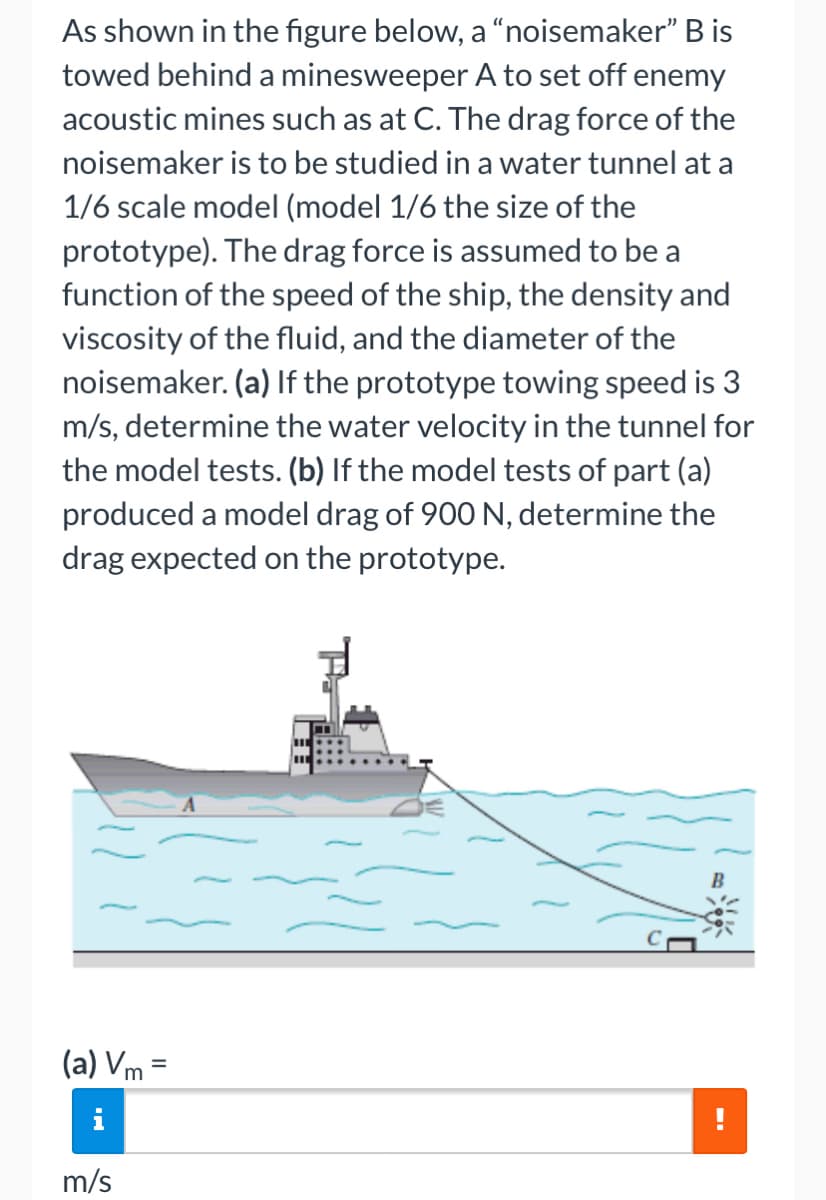As shown in the figure below, a "noisemaker" B is towed behind a minesweeper A to set off enemy acoustic mines such as at C. The drag force of the noisemaker is to be studied in a water tunnel at a 1/6 scale model (model 1/6 the size of the prototype). The drag force is assumed to be a function of the speed of the ship, the density and viscosity of the fluid, and the diameter of the noisemaker. (a) If the prototype towing speed is 3 m/s, determine the water velocity in the tunnel for the model tests. (b) If the model tests of part (a) produced a model drag of 900 N, determine the drag expected on the prototype.
As shown in the figure below, a "noisemaker" B is towed behind a minesweeper A to set off enemy acoustic mines such as at C. The drag force of the noisemaker is to be studied in a water tunnel at a 1/6 scale model (model 1/6 the size of the prototype). The drag force is assumed to be a function of the speed of the ship, the density and viscosity of the fluid, and the diameter of the noisemaker. (a) If the prototype towing speed is 3 m/s, determine the water velocity in the tunnel for the model tests. (b) If the model tests of part (a) produced a model drag of 900 N, determine the drag expected on the prototype.
Elements Of Electromagnetics
7th Edition
ISBN:9780190698614
Author:Sadiku, Matthew N. O.
Publisher:Sadiku, Matthew N. O.
ChapterMA: Math Assessment
Section: Chapter Questions
Problem 1.1MA
Related questions
Question
Please fast. Only final answer needed

Transcribed Image Text:As shown in the figure below, a "noisemaker" B is
towed behind a minesweeper A to set off enemy
acoustic mines such as at C. The drag force of the
noisemaker is to be studied in a water tunnel at a
1/6 scale model (model 1/6 the size of the
prototype). The drag force is assumed to be a
function of the speed of the ship, the density and
viscosity of the fluid, and the diameter of the
noisemaker. (a) If the prototype towing speed is 3
m/s, determine the water velocity in the tunnel for
the model tests. (b) If the model tests of part (a)
produced a model drag of 900 N, determine the
drag expected on the prototype.
(a) Vm =
%3D
m/s
Expert Solution
This question has been solved!
Explore an expertly crafted, step-by-step solution for a thorough understanding of key concepts.
This is a popular solution!
Trending now
This is a popular solution!
Step by step
Solved in 2 steps with 2 images

Knowledge Booster
Learn more about
Need a deep-dive on the concept behind this application? Look no further. Learn more about this topic, mechanical-engineering and related others by exploring similar questions and additional content below.Recommended textbooks for you

Elements Of Electromagnetics
Mechanical Engineering
ISBN:
9780190698614
Author:
Sadiku, Matthew N. O.
Publisher:
Oxford University Press

Mechanics of Materials (10th Edition)
Mechanical Engineering
ISBN:
9780134319650
Author:
Russell C. Hibbeler
Publisher:
PEARSON

Thermodynamics: An Engineering Approach
Mechanical Engineering
ISBN:
9781259822674
Author:
Yunus A. Cengel Dr., Michael A. Boles
Publisher:
McGraw-Hill Education

Elements Of Electromagnetics
Mechanical Engineering
ISBN:
9780190698614
Author:
Sadiku, Matthew N. O.
Publisher:
Oxford University Press

Mechanics of Materials (10th Edition)
Mechanical Engineering
ISBN:
9780134319650
Author:
Russell C. Hibbeler
Publisher:
PEARSON

Thermodynamics: An Engineering Approach
Mechanical Engineering
ISBN:
9781259822674
Author:
Yunus A. Cengel Dr., Michael A. Boles
Publisher:
McGraw-Hill Education

Control Systems Engineering
Mechanical Engineering
ISBN:
9781118170519
Author:
Norman S. Nise
Publisher:
WILEY

Mechanics of Materials (MindTap Course List)
Mechanical Engineering
ISBN:
9781337093347
Author:
Barry J. Goodno, James M. Gere
Publisher:
Cengage Learning

Engineering Mechanics: Statics
Mechanical Engineering
ISBN:
9781118807330
Author:
James L. Meriam, L. G. Kraige, J. N. Bolton
Publisher:
WILEY